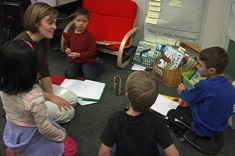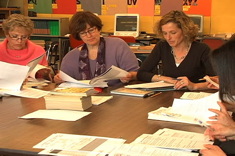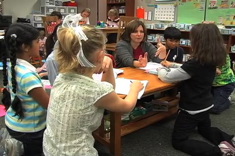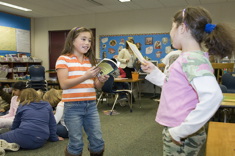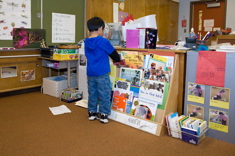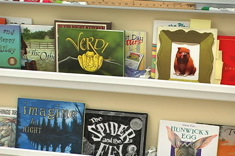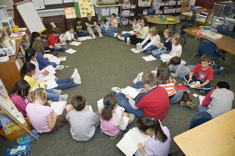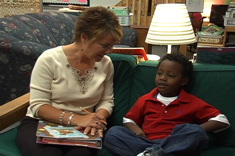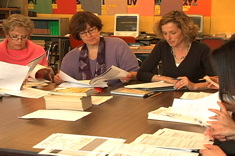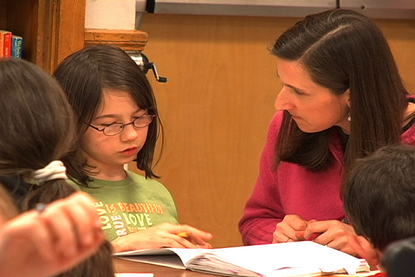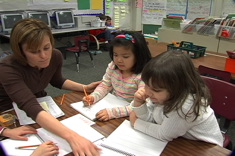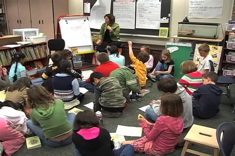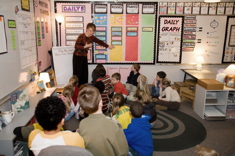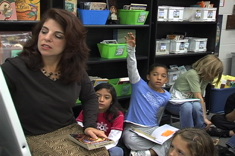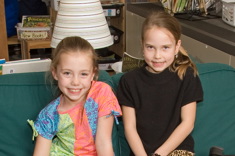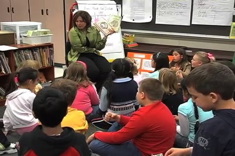Library
Choice Literacy Articles & Videos
The Choice Literacy library contains over 3,000 articles and 900 videos from 150+ contributors. Classic Classroom and Literacy Leadership subscribers have access to the entire library. Content is updated continuously, with five to six new features published each week.
Latest Content
Overcoming Tears and Fears: Developing Criteria for Flexible Groups
Katie DiCesare comforts a student in tears at the end of the day, and realizes part of the problem may be that she moved the child into a guided writing group too quickly.
Wide Open Spaces: Learning from “Not-Just-Right” Books
When is it okay for a child to read a "not-just-right" book, especially one with themes that might be a bit sophisticated or of questionable taste? Andrea Smith confronts this issue as a parent, and thinks through what it might mean for her teaching.
Moving from Data to Practice
Clare Landrigan and Tammy Mulligan give advice for how to create databases and graphic analyses of assessment information that teachers can readily access and use.
The Draw-a-Reader Test: Informal Assessment Supporting Teacher Inquiry
The Draw-a-Reader test from Suzy Kaback is a fun way to get to know the readers of any age that also provides insight into their background knowledge and personal reading histories.
Tips for Saving Time from Literacy Leaders
Time-saving tips from contributors including Aimee Buckner, Debbie Miller, Ruth Shagoury, Shari Frost, Karen Szymusiak and "The Sisters" (Gail Boushey and Joan Moser).
Easing into Assessments During the First Six Weeks of School
Franki Sibberson and Karen Szymusiak have suggestions for integrating observations and assessments of students naturally into reader's workshops during the first six weeks of school.
“I Used to . . . Now I”
Looking for a thoughtful and feel-good icebreaker for a staff meeting or study group? Ruth Shagoury uses the “I Used to…Now I” prompt to get colleagues thinking and talking about changes in their literacy instruction over the years, as well as where they might go next in their teaching.
Books that Invite Student Participation
Franki Sibberson has suggestions for read-alouds that encourage kids to participate.
Characters We Love (BOOKLIST)
Nothing hooks kids on books more than a favorite character. Franki Sibberson presents some series books with intriguing characters that will delight your students.
Multicultural Books for Beginning Readers
“Why isn’t there an African American Henry and Mudge?” asks a teacher. This question leads Shari Frost on a quest to find the best early readers for multicultural students. In this booklist, she highlights her top picks.
Music for Literacy Leaders
Reflective? Rollicking? If you’re trying to set a tone for anything from an assessment team meeting to a one-minute transition in a second-grade classroom, our Music for Literacy Leaders playlist has just the right song for you.
Starting the School Year: A Checklist for Literacy Coaches
With all the checklists for launching the school year available for teachers, isn't it about time someone developed one for literacy coaches? Jan Miller Burkins has done just that – her Launching the Year Checklist is concise, and tackles everything from reformatting computer files to touching base with each teacher.
Letting Students Define and Design My 6th Grade Classroom Library
Katie Doherty's 6th graders take charge of the classroom library, with an activity designed to build an understanding of genre at the same time.
Making Time for Nonfiction Read Alouds
Franki Sibberson considers the issue of selecting nonfiction books for read-aloud time, and in doing so creates one of her popular booklists.
What’s the Most Beautiful Thing You Know About…?
Ruth Shagoury and Melanie Quinn asked their colleagues to share the “most beautiful thing” about the puzzling student each of them is looking at closely in their study group. This is a great activity you’re looking for a quick and easy icebreaker to spark some positive energy in your next study group or staff meeting, and remind everyone of the joys of our profession.
Just Because It’s Skinny, Doesn’t Mean It’s Easy: Matching Books to Transitional Readers in Grades 2-4
Franki Sibberson writes about her evolution in choosing books for transitional readers in grades 2-4. Franki includes a handy list of criteria for evaluating whether new short chapter books are appropriate for young readers.
Conferring with Children: Principles and Procedures
“The Sisters” (Gail Boushey and Joan Moser) share their principles and procedures for conferring in the classroom.
Opening Classroom Doors
Clare Landrigan and Tammy Mulligan share many nonthreatening techniques to break down resistance among teachers to classroom visits and collaboration.
The Porch in August: Letting It Be
Shirl McPhillips reminds us "in the face of all that tugs at us from the past and from what's to come, we can step into the moments of the day with our students and take pleasure in what we find there." Such wise words for any time we need to hit the pause button in our lives.
Learning with Intensity: A Study Group Discussion Prompt
"Learning with Intensity" is a study group activity which takes participants back to a time when they became passionately involved with learning. Ruth Shagoury shares the structure of the activity and insights from one group who gave it a test drive.
Creating Structures to Sustain Our Work
Jennifer Allen explains how she enlisted teachers to lead a day-long inservice.
Ode to a Sweet Snowy Day for Two
Shirl McPhillips’ poem “Ode to a Sweet Snowy Day for Two” is designed for paired reading. Shirl also gives advice for celebrating poetry as an oral art in classrooms.
Messengers
This is a lovely poem with a message about how poetry can move us, and why it is essential in classrooms.
Collecting Literacy Stories Icebreaker (PRINT DOWNLOAD)
If you want a terrific activity to nudge colleagues to share more of their successes and failures, you might want to download Cindy Hatt’s question templates and explanation of the collecting stories activity. It’s also a fun strategy for building listening skills and community among teachers and coaches
Assessing Spelling in Writing Workshop Part 2: Noticing Patterns in Individuals, Small Groups and the Whole Group
Katie DiCesare took on the challenge of developing a one-page assessment tool to analyze the spelling needs and abilities of each of her 1st graders. In the second of her three-part series, Katie shows how she translates the findings from individual students into instructional plans.
Reflecting on the First Six Weeks of Word Study
Franki Sibberson explains how she rethought word study during the first six weeks of school, giving manypractical examples of activities and routines with her intermediate students.
Meeting Areas (Design Photo Essay Series)
Design tips from “The Sisters” (Gail Boushey and Joan Moser) for beautiful and functional meeting areas.
Teaching Themes Through Keywords
Aimee Buckner presents a simple strategy for helping students look for themes as they read a new text.
Strong Girls (BOOKLIST)
If Nancy Drew was an important literary role model for you when you were a preteen, you might enjoy a peek at the sassy new gals who are influencing our tweens.
Short Units, Big Messages
Those "in-between" writers in grades 3 and 4 present special challenges to teachers. Some are fluent and versatile, writing page after page of drafts. Other students struggle to craft even a sentence. Franki Sibberson explains how short texts and brief genre units can help intermediate writers with a wide range of abilities.
Browse Content By
Type
Category
- Assessment Tools
- Big Fresh Archives
- Booklists
- Choice Numeracy
- Classroom Design
- Common Core
- Community Building
- Conferring
- Content Literacy
- Digital Literacy
- English Language Learners
- Equity
- Family Relations
- Free Samples
- Guiding Groups
- Leadership
- Literacy Coaches
- Mentor Texts
- Minilessons
- New Teacher Mentors
- Podcasts
- Poetry
- Quote Collections
- Reading Strategies
- Self Care
- Struggling and Striving Learners
- Talking and Listening
- Teacher Study Groups
- Teaching Reading
- Teaching Writing
- Word Study and Vocabulary
Author
- Melissa Quimby
- Nawal Qarooni
- Gwen Blumberg
- Julie Cox
- The Lead Learners
- Hannah Tills
- Josie Stewart
- Ruth Metcalfe
- Mallory Messenger
- Becca Burk
- Jodie Bailey
- Vivian Chen
- Mary Brower
- Tiffany Abbott Fuller
- Stephanie Affinito
- Ruth Ayres
- Leigh Anne Eck
- Heather Fisher
- Shari Frost
- Julie Johnson
- Suzy Kaback
- Gigi McAllister
- Shirl McPhillips
- Melanie Meehan
- Cathy Mere
- Debbie Miller
- Tara Barnett and Kate Mills
- Tammy Mulligan
- Dana Murphy
- Bitsy Parks
- David Pittman
- Brenda Power
- Heather Rader
- Matt Renwick
- Mandy Robek
- Christy Rush-Levine
- Gretchen Schroeder
- Jen Schwanke
- Brian Sepe
- Katherine Sokolowski
- Stella Villalba
- Jennifer Vincent
Grade Level
Choice Literacy Membership
Articles
Get full access to all Choice Literacy article content
Videos
Get full access to all Choice Literacy video content
Courses
Access Choice Literacy course curriculum and training

